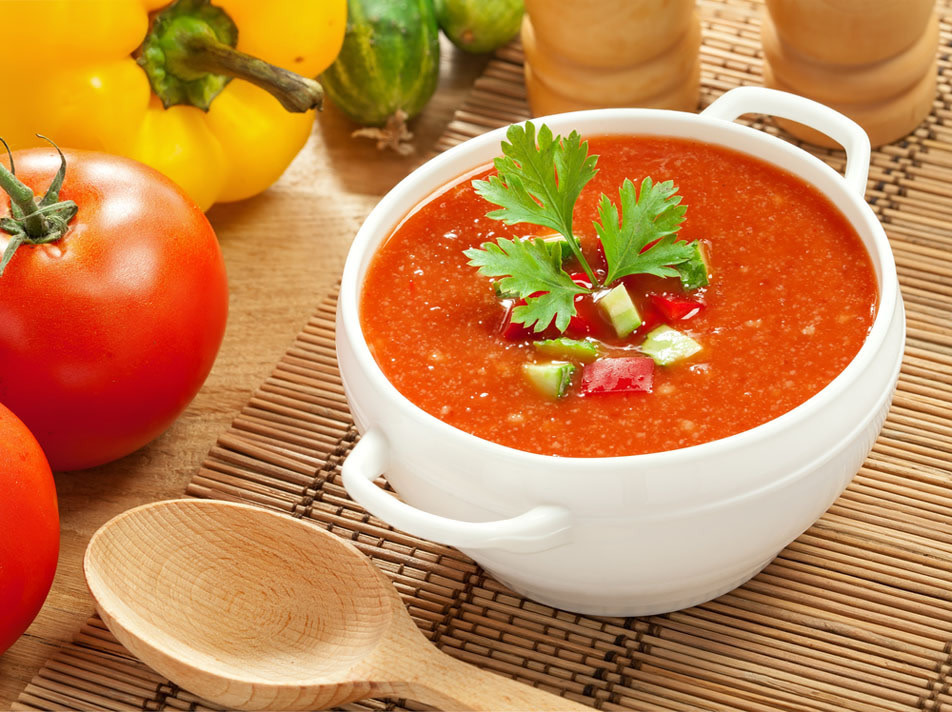Go Loco for Gazpacho

Image: Courtesy Maxim Khytra
Gazpacho is a quintessential summer dish, namely because it is brimming full of that precious bounty of late summer, tomatoes. A great gazpacho depends on ripe and really ready fresh tomatoes. Vaguely tomato-ish facsimiles available year round will not suffice.
So now that we’ve got some of the real thing in our farmers markets, lets get out the blender and go loco for gazpacho. Actually, we can leave the electrical appliance alone if we want; a knife can do the job of dicing our fresh vegetables for a classic soup. But use what you like: part of the beauty of gazpacho is that you can vary the preparation methods and ingredients endlessly, to match your tastes and mood.
Quintessential as it is, essentially gazpacho is a cold, refreshing soup of chopped, uncooked tomatoes. Cucumbers are the important supporting player, and vinegar or lemon juice perk up the flavors. Beyond that, almost anything goes. (We’ve heard that West End modernist-tapas restaurant Racion is serving an almond gazpacho with razor clam, Dungeness crab and a homemade ginger marshmallow.)
Gazpacho (which comes from Spain originally) tends to be juicy and soupy because tomatoes are a primary ingredient. It need not be completely smooth nor swimming in added canned tomato juice (though some recipes, including that in the original 1970s Moosewood cookbook, will recommend as much).
Preparation methods will affect the texture:
- Blender – easiest to get smooth results
- Food processor – also good for smoothness
- Immersion blender – easier to get chunkier results
- Knife – use an old fashioned handheld to chop ingredients finely enough to get their juices flowing, and mix them in a bowl.
Garnishes and ingredient variations will also affect the texture and flavor:
- Adding chunks of stale bread to the pureed (or chunky) mixture will thicken gazpacho with a neutral creaminess.
- Almonds added to the blend will thicken with a touch of nutty crunch (think of it as the equivalent of a pesto, with its pine nuts or walnuts blending with basil).
- Adding olive oil smoothes out the consistency.
- Onions, shallots, hot peppers and garlic for zip
- Fresh herbs (basil, cilantro, parsley); avocado (both are nice for color contrast to the orange/red tomato).
Basic Red Gazpacho
- About 3 lbs. ripe tomatoes, cored and peeled
- 1 red, yellow or green bell pepper, stemmed, peeled if desired, seeded and roughly chopped
- 2 cucumbers (pickling "Kirby"-type preferred), peeled and roughly chopped
- 4 slices good stale white bread (about 4 ounces), crusts removed
- 6 cups cold water
- 1 large or 2 small cloves garlic, peeled
- 1/4 cup sherry or good wine vinegar, or to taste
- Salt and freshly ground black pepper to taste
- Croutons for garnish (optional)
Place the bread in the container of a blender or food processor with the remaining tomato, pepper, cucumber, and water, as well as the garlic and vinegar; process until smooth, then add the olive oil slowly, with the machine running. Season with salt and pepper and refrigerate until ready to serve; the flavor will improve over a few hours. Check seasoning again before serving. Garnish with reserved tomato, pepper and cucumber, and croutons if desired.




